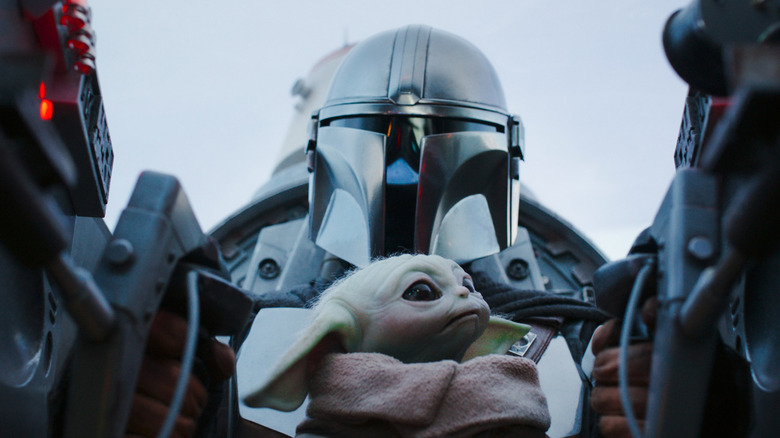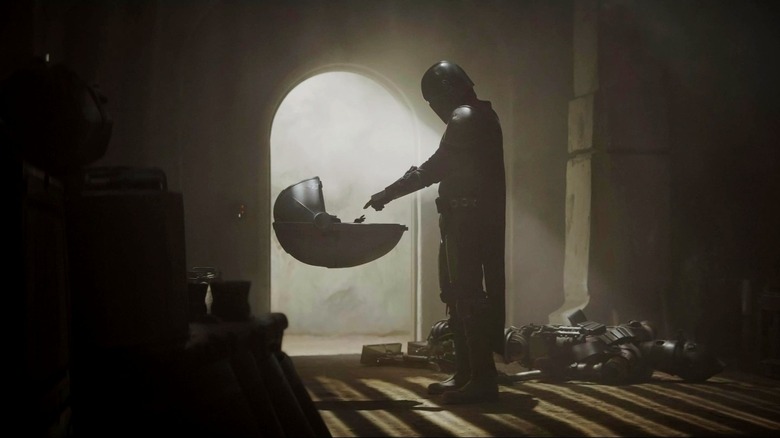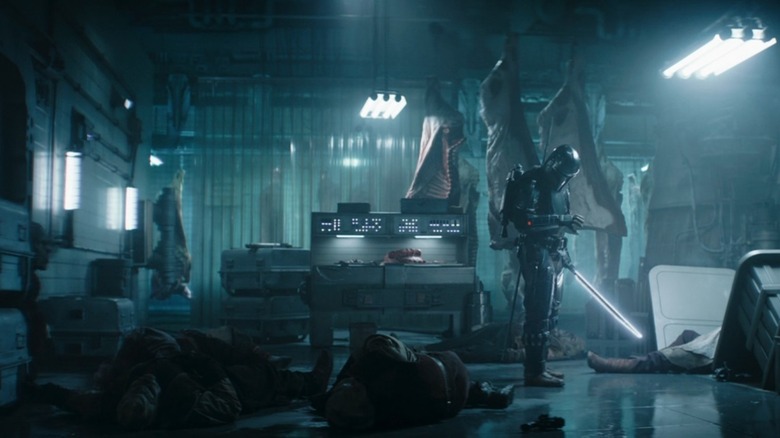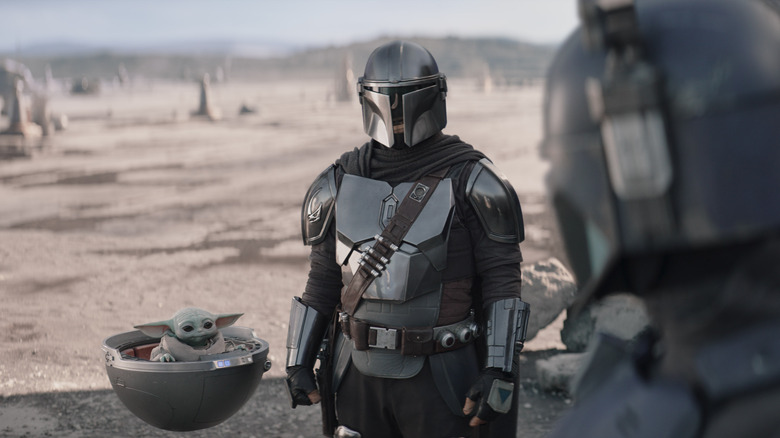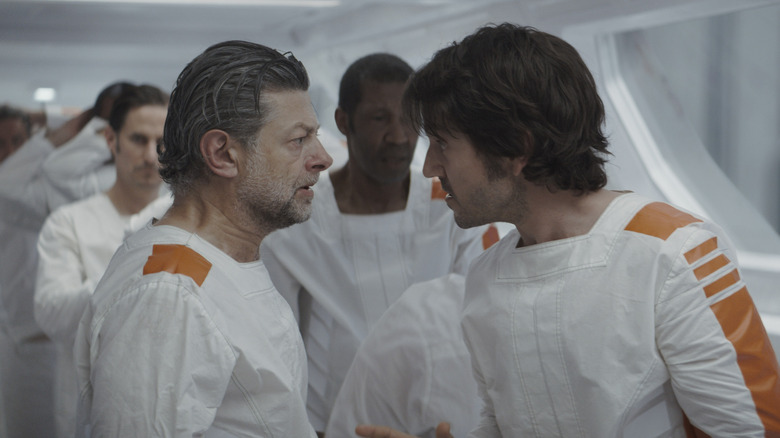Star Wars Is Ruining The Mandalorian
In the climactic scene of "The Mandalorian" season 3, episode 3, "The Convert" — a "Brazil"-influenced, Coruscant-set cautionary tale about the machines of power and the stubbornness of evil — poor Dr. Penn Pershing has been betrayed, while acting with good intentions. Now he's strapped to a table, about to be brainwashed by a feared former Imperial tool called the "mind flayer." In the depths of his terror and despair, he pleads for mercy with the Mon Calamari doctor, telling him: "It was a trap!"
You know, like Admiral Ackbar? Remember when Admiral Ackbar said "it's a trap!" in "Return of the Jedi"? And people liked that line, and when internet memes were invented it became a meme? It's just like the meme, except now someone is saying it to a Mon Calamari character instead? Isn't that funn– Oh, Dr. Pershing just got his brain fried.
The latest chapter of "The Mandalorian," "The Pirate," drops in another unpopped popcorn kernel of fan service when Greef Karga and pirate king Gorian Shard have an argument about Gorian's reasons for attacking Nevarro. When Gorian accuses Greef of gunning down his minions in the street, Greef retorts: "He shot first."
Remember, like when Han shot first? And then George Lucas went back 20 years later and re-edited the scene so that Greedo shot first? And then "Han shot first" became a whole thing? Now a "Star Wars" show is joking about the "Han shot first" thing!
In isolation these Easter eggs wouldn't be cause for much complaint, thuddingly unsubtle though they might be. But in "The Mandalorian," they're symbolic of how a once-promising show has tragically fallen prey to its parent franchise.
This is the Way
Let's address something right up front: if you're a hardcore "Star Wars" fan and you've seen everything the franchise has to offer, including the animated series "Star Wars: The Clone Wars" and "Star Wars Rebels," and even the kids' game series "Star Wars: Jedi Temple Challenge" where Kelleran Beq made his debut, "The Mandalorian" season 3 may be delivering everything you could possibly want from a "Star Wars" series. This one is going out to my fellow filthy casuals, who enjoyed the "Star Wars" movies well enough but have only seen them once or twice, and are fairly ignorant of the canon beyond that.
"The Mandalorian" season 1 threw its arms wide open and welcomed in everyone: hardcore fans, filthy casuals, and your dad who has never watched a "Star Wars" movie and is only half-watching this show. All you really need to know to start watching is that there used to be a big evil Empire and now there's not, and even if you don't know that you can pick it up along the way from context clues. Mandalorians had been seen before in the "Star Wars" universe, but Din Djarin's covert is unique and follows its own set of rules that, conveniently, need to be explained to the audience.
After the disappointment of "Star Wars: The Rise of Skywalker," which concluded the sequel trilogy by clinging anxiously to the original trilogy's skirts, "The Mandalorian" felt bold and fresh and interesting. Once the series premiere closed with that indelible image of the tough lone wanderer reaching out to the adorably ugly green baby in the floating crib, everyone was hooked.
Is this the Way?
Somewhere in the middle of "The Mandalorian" season 2, the show seemed to grow concerned that the Lone Wolf and Cub weren't enough by themselves; they needed deeper ties to the rest of the franchise. Bo-Katan Kryze and Ahsoka Tano showed up (to find out more about those characters, watch 200-plus episodes of the "Star Wars" animated shows, plus the "Star Wars: The Clone Wars" animated film). Somehow, Boba Fett returned (to find out how Boba Fett returned, watch "The Book of Boba Fett"). And then the crowning jewel: Luke Skywalker himself, appearing via a body double, a digital simulation of Mark Hamill's voice, and a digital simulation of Mark Hamill's face.
Oh, you thought that watching "The Book of Boba Fett" was just a suggestion? Nope. Anyone naïve enough to try watching "The Mandalorian" season 3 immediately after the second season will experience the whiplash of Din Djarin and Grogu's heart-rending goodbye, followed by the two of them being back together again with zero explanation. Even the "Previously on..." recap omits the explanation of how and why Grogu returned. To catch up on the adventures you missed, you'll need to watch episodes 5-7 of "The Book of Boba Fett." Just don't expect to see much of Boba Fett in those episodes.
It might be years before we get the tell-all book about exactly what went wrong with "The Book of Boba Fett," and how it led to the show mostly dropping Boba Fett halfway through and turning into a weird mini-season of "The Mandalorian." Perhaps it simply proved too difficult to write a whole TV show about a legacy character who only had four lines of dialogue in the original trilogy. But whatever the reason, it meant that "The Mandalorian" went from gently nudging viewers towards other "Star Wars" shows to making one of those shows mandatory viewing.
Error 404 Way not found
The common retort to complaints that "The Mandalorian" doesn't really seem to be about the Mandalorian any more is, "well, they didn't say which Mandalorian." And it's true, double meanings are part of the show's personal brand. The episode title "The Convert," for example, refers both to Dr. Pershing as a convert to the New Republic, and Bo-Katan as a new convert to the Children of the Watch. Based on what we can from this odd, disjointed season so far, the titular Mandalorian of "The Mandalorian" season 3 is Bo-Katan, not Din Djarin.
That's not necessarily a bad concept. "The Wire" also drew criticism when it completely shifted its focus in season 2, but it was part of the overall design for the series, which is now considered one of the best TV shows ever made. However, "The Wire" season 2's new main characters were fully developed inside "The Wire." There isn't an animated series in the "Wire" cinematic universe featuring a Frank Sobotka origin story that you can watch for extra credit.
As far as "The Mandalorian" is concerned, Bo-Katan Kryze hasn't actually done all that much. She teamed up with Din Djarin for a couple of missions in season 2, sulked on a chair until season 3 arrived, and then sulked on a chair some more. Grogu eventually dragged her away from the chair to help rescue his dad, and she went for a swim and saw a mythosaur. There was the weird dinosaur bird episode. And now the Armorer has proclaimed Bo-Katan to be the Mandalorian who will unite all other Mandalorians and restore Mandalore to its former glory. It's not unearned in the wider context of "Star Wars: The Clone Wars" and "Star Wars Rebels," but it feels very unearned in "The Mandalorian."
Meanwhile, Din Djarin has been reduced to just kind of hanging out in the background (where he's presumably fuming about the Armorer giving Bo-Katan a Get Out Of Helmet Free card just three episodes after he had to go to Mandalore, almost get desiccated by a cyborg, and then almost drown in his quest to be "redeemed" for removing his helmet).
Friendship ended with Mando, now Andor is my best friend
Perhaps there's some unspoken rule that there can only be one great standalone "Star Wars" TV show at any given time. If that's the case, I'm happy to leave "The Mandalorian" and take "Andor" in exchange. Based on current trends, Grogu's first full sentence is probably going to be "got a bad feeling about this, I have" — but at least we have Stellan Skarsgård delivering his "I've made my mind a sunless space" monologue.
The only prominent legacy character in "Andor" is Mon Mothma, but crucially her storyline never feels like it's resting on the laurels of "Star Wars: The Clone Wars" (a show that "Andor" creator Tony Gilroy probably hasn't watched). Instead, it gives her a rich and complex arc that's integral to the broader theme of the show: exploring the reasons why people from all walks of life choose to rebel against the Empire, and what price they pay for that choice.
You can, feasibly, go into "Andor" without having seen anything else that the "Star Wars" galaxy has to offer, and follow the plot without feeling like you're missing out on any vital details. Hell, if you don't have time to watch the whole show, episodes 4-6 and 8-10 independently function as self-contained stories about a grand heist and a prison break, respectively.
Yes, it's a bit surprising that a prequel to a prequel to the very first "Star Wars" movie is the most accessible and self-contained story the franchise has to offer. And yes, "Andor" reportedly has the lowest viewership out of all the "Star Wars" show on Disney+. But who cares? It was created with a two-season plan and season 2 is already filming, so ratings have no power over "Andor" any more. Besides, no one watched "The Wire" either.
